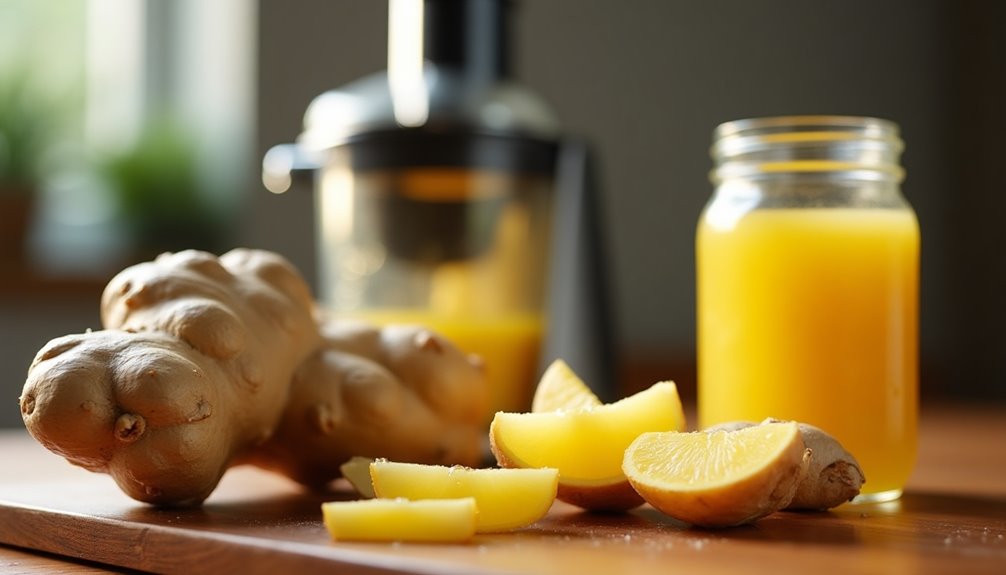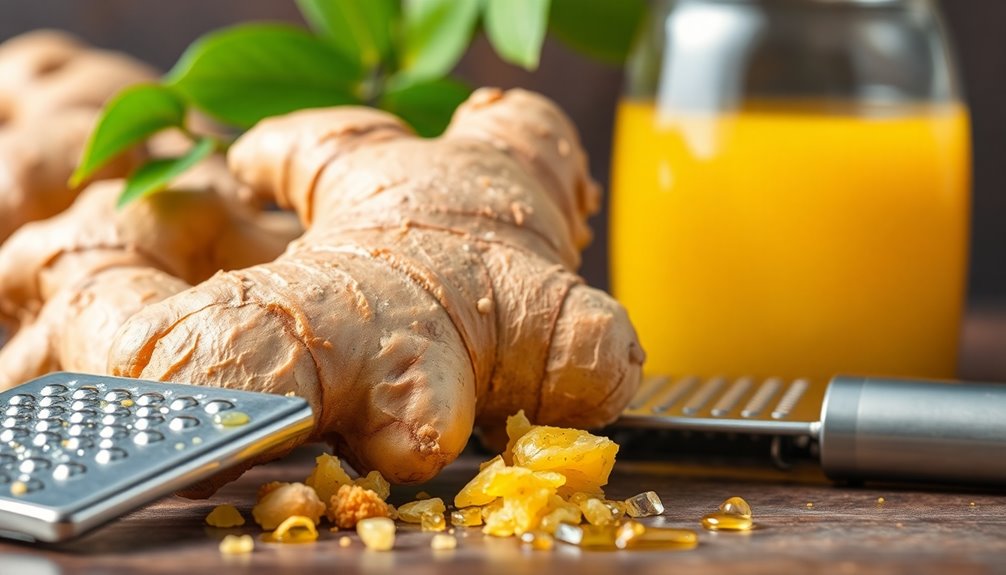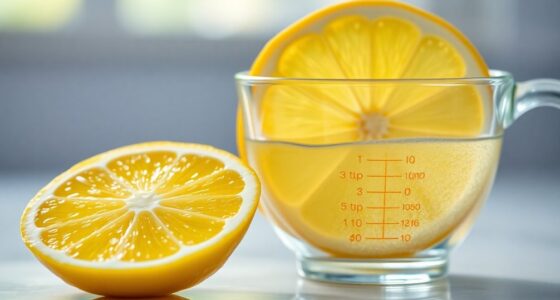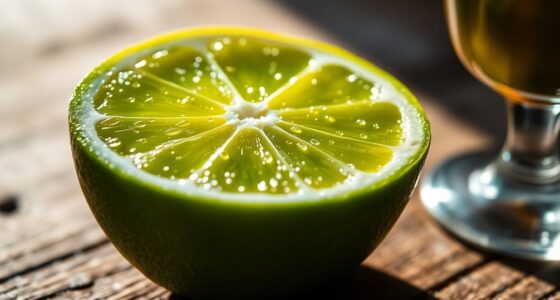To make ginger juice, start by peeling and chopping fresh ginger into 1-inch pieces. Blend the ginger with a cup of filtered water until smooth. Strain the mixture through a fine mesh sieve or cheesecloth to extract the juice. You can enhance the flavor with lemon juice, maple syrup, or a pinch of black pepper. Store your ginger juice in an airtight container in the fridge for up to three days, and there's plenty more to learn about flavor combinations!
Key Takeaways
- Peel and chop fresh ginger into 1-inch pieces to facilitate blending.
- Blend chopped ginger with a cup of filtered water until smooth for optimal juice extraction.
- Strain the blended mixture through a fine mesh sieve or cheesecloth to collect the juice.
- Enhance the flavor by adding lemon juice, maple syrup, or a pinch of black pepper.
- Store ginger juice in an airtight glass container in the refrigerator for up to three days.

Ginger juice is a refreshing and health-boosting addition to your diet, and making it at home is easier than you might think. With just a few simple ingredients and steps, you can create a delicious homemade ginger juice that's packed with flavor and health benefits. Let's dive into how you can make ginger juice right in your kitchen.
First, gather your ingredients. You'll need fresh ginger, filtered water, and any optional flavor enhancers you might like, such as lemon juice, maple syrup, or a pinch of black pepper. Choose fresh ginger that's firm and has a spicy aroma. It's crucial to use fresh ingredients to maximize the flavor and health benefits of your juice.
To start, peel and chop the ginger into 1-inch pieces. This makes it easier to blend and extract the juice. If you have a juicer, you can skip the blending step altogether, as a juicer extracts more juice without needing to add additional water.
However, if you're using a blender, add the chopped ginger pieces to the blender along with a cup of filtered water. Blend the mixture until it's smooth. The blending process helps break down the ginger fibers, allowing for a better extraction of juice.
Once blended, it's time to extract the juice. You can do this by straining the mixture through a fine mesh sieve or a cheesecloth into a bowl or pitcher. Press down on the pulp to extract as much liquid as possible. The result is a vibrant ginger juice that you can enjoy immediately or store for later.
If you're looking to enhance the flavor and health benefits, consider adding a splash of lemon juice for tartness, a bit of maple syrup for sweetness, and a pinch of black pepper, which can help improve the absorption of ginger's beneficial compounds.
For storage, pour your homemade ginger juice into an airtight glass container and keep it in the refrigerator. It'll stay fresh for up to three days. If you want to store it for longer, consider pouring the juice into ice cube trays and freezing it. This way, you can pop out a cube whenever you need a boost of flavor or health benefits.
When it comes to daily consumption, aim for about 30ml of ginger juice to experience its health benefits, which include improved digestion and relief from nausea. You can enjoy it straight, mix it into smoothies, or even add it to your favorite teas for an extra kick.
Making ginger juice at home isn't only simple but also rewarding. You'll have a fresh, delicious juice that you can enjoy in various ways. So go ahead, make ginger juice, and experience its refreshing flavor and health benefits for yourself!
Frequently Asked Questions
What Is the Best Way to Juice Ginger?
The best way to juice ginger involves using a high-speed blender or a juicer.
If you're blending, chop peeled ginger into 1-inch pieces, add water, and strain the mixture. If you prefer a juicer, just wash the ginger and feed it in without peeling.
You'll get about ½ to ¾ cup of juice from 1 pound. To boost flavor, mix in some lemon juice or coconut water while blending.
Store it in an airtight container.
Is It OK to Drink Ginger Juice Everyday?
Did you know that a study found that consuming just 1-2 grams of ginger daily can significantly reduce nausea?
It's generally safe for you to drink ginger juice every day, as long as you stick to about 4 grams.
Regularly enjoying ginger juice can help with digestion and provide anti-inflammatory benefits.
Just be mindful of moderation; too much might cause some discomfort.
Always consult your healthcare provider if you have specific health concerns.
How to Make Fresh Ginger Drink?
To make a fresh ginger drink, start by peeling and chopping a small knob of ginger into 1-inch pieces.
Blend those pieces with a cup of water until smooth.
Strain the mixture through a fine mesh strainer to get the juice, pressing the pulp for maximum yield.
Sweeten it with honey or maple syrup, add a splash of lemon juice, and enjoy your refreshing drink!
Store it in the fridge for up to 3 days.
Do I Need to Peel Ginger to Juice It?
You don't necessarily need to peel ginger before juicing it. If you're using a juicer, it can handle unpeeled ginger just fine.
However, if you're blending, peeling might help reduce bitterness and unwanted flavors. If your ginger is organic, feel free to skip the peeling, as the skin's safe and nutritious.
Keep in mind that peeling can also remove dirt and impurities, so it's often a good practice.
Conclusion
Now that you know how to make ginger juice, why not give it a try? With its refreshing taste and numerous health benefits, it's a simple addition to your diet that can enhance your well-being. Whether you enjoy it on its own or mix it into smoothies or teas, ginger juice can invigorate your day. So, what are you waiting for? Grab some fresh ginger and start juicing—your taste buds and body will thank you!
Cindy thoroughly researches juicing trends, techniques, and recipes to provide readers with practical advice and inspiration. Her writing style is accessible, engaging, and designed to make complex concepts easy to understand. Cindy’s dedication to promoting the advantages of juicing shines through her work, empowering readers to make positive changes in their lives through the simple act of juicing.
















